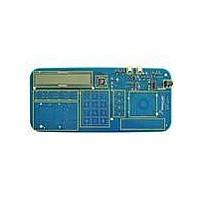TSSEVB Freescale Semiconductor, TSSEVB Datasheet - Page 10

TSSEVB
Manufacturer Part Number
TSSEVB
Description
BOARD EVALUATION TOUCH SENSING
Manufacturer
Freescale Semiconductor
Datasheet
1.TSSEVB.pdf
(31 pages)
Specifications of TSSEVB
Sensor Type
Touch, Capacitive
Interface
USB
Embedded
Yes, MCU, 8-Bit
Interface Type
USB, I2C, SCI, SPI
Operating Voltage
5 V
Data Bus Width
8 bit
Lead Free Status / RoHS Status
Lead free / RoHS Compliant
Voltage - Supply
-
Sensitivity
-
Utilized Ic / Part
-
Sensing Range
-
Lead Free Status / Rohs Status
Lead free / RoHS Compliant
For Use With/related Products
S08LG32
and automotive applications, such as electric metering, home appliances, HVAC systems, and entry level
instrument cluster. The MC9S08LG32 has 32 KB of on-chip programmable flash memory and 2 KB of
RAM available.
The MC9S08LG32 provides an LCD driver module, configurable up to 8 × 37 or 4 × 41. The LCD driver
module remains active even in low-power modes. It also includes an internal regulated charge pump for
contrast control. All LCD pins are multiplexed with GPIOs.
TSSEVB uses the MC9S08LG32 Inter-Integrated Circuit (IIC) module to establish communication with
the MC9S08JM60 Comm MCU when the TSSEVB is used along with EGT. To use the IIC module with
the EGT, jumpers on headers J10 and J11 respectively must be properly configured. For more information
on jumper configurations, refer to
The EVB includes two MC9S08JM60 MCUs, one is open source BDM that is used to program and debug,
while the other is used to communicate with the EGT GUI on a PC.
The MC9S08LG32 includes a Serial Communication Interface (SCI) module. The SCI module can be
connected to both MC9S08JM60 MCUs included in the TSSEVB and you can select either by changing
the position on J1 and J2 jumpers. The SCI module is included in the TSSEVB for future demo
applications.
MC9S08LG32 is packaged in an 80-pin quad flat non-lead package (QFN).
2.1.3
MC9S08LG32 has nine I/O ports that include a total of up to 69 GPIO pins. Most of these pins are shared
with the on-chip peripherals such as timer systems, external interrupts, or keyboard interrupts. When these
modules are not controlling the port pins, they revert to GPIO control. Immediately after reset, all 69 GPIO
pins are configured as high-impedance general-purpose inputs with internal pull-up devices disabled. The
port allocation of the general-purpose I/O and on-chip peripheral functions on the EVB are listed in
Table 2-1
Freescale Semiconductor
PTA5/KBI6/TPM2CH0/ADC3/LCD26
PTA6/KBI7/TPM2CH1/ADC4/LCD27
PTA4/KBI5/RX2/ADC2/LCD25
PTA3/KBI4/TX2/ADC1/LCD24
PTA7/TCLK/ADC5/LCD28
PTA2/SDA/ADC0/LCD23
PTA1/SCL/LCD22
along with a brief description.
PTB0/LCD29
PTB1/LCD30
PTA0/LCD21
General-Purpose I/O and Peripheral Ports
MCU Port
Touch Sensing Software Evaluation Board Users Guide, Rev. 6
Section 2.3, “Header and Jumper
TSSEVB Functionality
OSBDM_RX/COM_RX
OSBDM_TX/COM_TX
Table 2-1. GPIO Port Allocation
ESLIDER1
ESLIDER2
LCD21
ETK_6
Buzzer
ETK_5
EGR1
ER9
I/O
I/O
O
O
I
I
I
I
I
I
I
Connections.”
Numeric Keyboard Electrode
Numeric Keyboard Electrode
SCI Transmitter (future use)
Rotary Structure Electrode
Slider Structure Electrode
Slider Structure Electrode
SCI Receiver (future use)
Different Size Electrode
LCD Control pin
Description
Buzzer
System Overview
2-3










